|
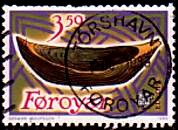
|
Maritime Topics On Stamps :
The Very First Boats, Dugouts!
|
This site represents only boats or canoes featuring a dugout as a hull.
Other types of canoes shall be presented at some later time.
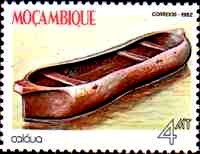
|
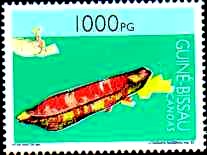
|
|
Dugouts represent the first boats constructed by man. According to the ‘out
of Africa’ theory, dugouts first appeared some 40,000 years ago. Prehistoric
man got hold of drifting logs to move across bodies of water. Later on,
several logs were bundled together to make rafts. Next, the logs were
hollowed out to become dugouts. In 1997 a 7,000 year old dugout was
discovered at Ireland’s Shannon River; a year later a slender dougout dated
8,000 years ago was found in Nigeria.
|
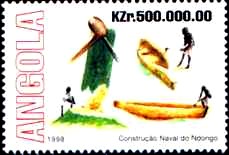
|
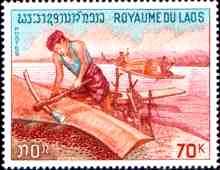
| |
Dougouts aren’t confined to certain limited regions, they were made all over
the world. Even today, they exist in the tropics. European dugouts were four
to six meters long, determined by the straight lenghts of the logs, of
course. Rain forest areas saw dugouts with lengths of 20 to 30 meters. Logs
came from trees uprooted by nature, or trees that were felled by setting fire
to their base.
|
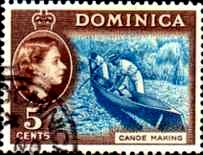 |
Fire was also used on logs for rough hollowing-out, followed by carving-out
with tools of bone or stone. Moist soil or moss prevented burn-throughs in
the case of very thin wooden walls. Dugouts in Bengal were widened by pouring
boiled water into the hull and pushing the sides apart with crossbeams.
|
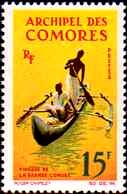
|
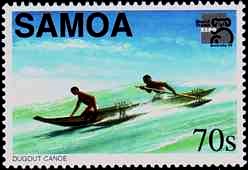
|
|
A dugout is rather wobbly and capsizes easily. To keep it stable, man
invented the outrigger, another log somewhat shorter and lighter than the
dugout. It was fastened parallel to the dugout by means of flexible
crossbeams, which allowed smooth movement with the waves. This technique was
widely employed in the island archipelagos of South East Asia and throughout
the Pacific. Outriggers were used either singly or on both sides; they were a
prerequisite for rigging with mast and sail.
|
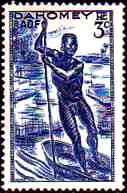
|
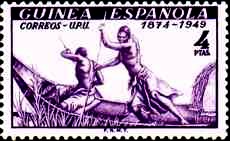
|
|
Poles were used to move in shallow waters; paddles, when it was possible to
sit or knee down in the dugout.
|
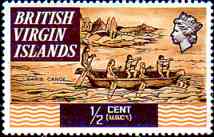
|
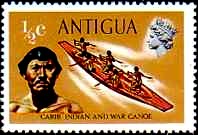
|
|
In the Caribbean, dugouts were called ‘canoa’ or ‘cenu’ - hence the English
word ‘canoe’. The Tainos of Hispaniola are known to have used boats with up
to 80 rowers and 30 meter lengths. More common were the sizes shown on these
stamps. The canoe on the right is a ‘streamlined’ war canoe.
|
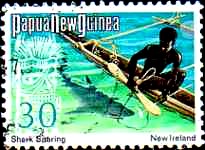
|
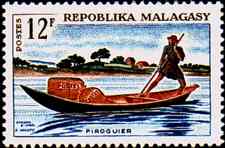
|
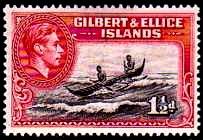
|
|
Dougouts were used for travel, transport of goods, fishing, competitive
races, and warfare. On the left, a shark is being snared; center and right
stamps show a canoe being skillfully steered through the surf.
|
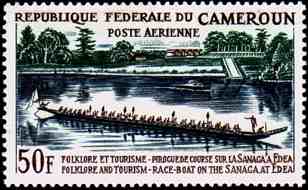
|
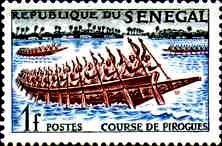
| |
A pirogue is a dugout with planks added to the sides for a higher freeboard,
clearly visible on the stamp at right. The most giant-sized pirogues were
those built in Africa wherever very high trees were found. They were 30 to 40
meters long and rowed by up to 80 natives. After abolishment of slaving raids
and inter-tribal warfare, they were mostly built for competetive racing. To
this day, the dragon boats of China are among the largest dugouts.
|
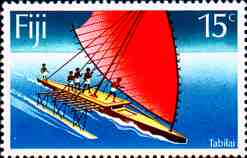
|
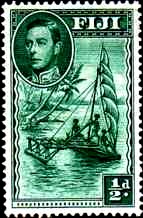
| |
At left we see a pirogue with outrigger and sail, a type seaworthy for open
ocean voyaging. The outrigger’s strong cross-stability allows for the setting
of rather large sails. The right stamp shows a ‘camaku’, a small dugout with
outrigger and sail for coastal waters. The vessel’s bow and stern are shaped
alike and the mast can be rotated, for sailing in either direction. The
outrigger always remains on the windward side.
|
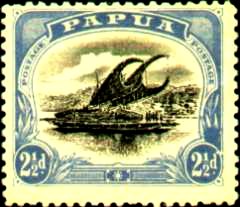
|
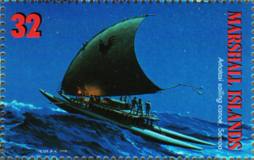
| |
The ‘lakatoi’ was a large sailing craft found in the coastal waters of New
Guinea. The hull consisted of two, three, or four pirogues lashed together
with crossbeams and topped by a platform made of bamboo. Often there were
small huts built upon this deck, as well as one or two masts. Claw-shaped
sails were customarily made of matting woven from the leaves and branches of
sago trees. But there were also four-sided and elliptically shaped sails.
|
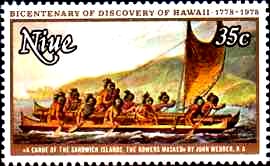
|
A war canoe of the South Seas. The boat consists of two hulls joined together
by planking, a mast and a sail. There are ten rowers. The warriors are
adorned with war paint on their faces and bodies.
|
|
The Haida ceremonial canoe featured here is a permanent exhibit in New York’s
Museum of Natural History. The Haidas, natives of Queen Charlotte Islands on
Canada’s West Coast, built their 15 to 20 meters long canoes from Cedar tree
logs. These canoes were approx. 2 meters wide, had a 5 ton cargo capacity,
and a crew of ten rowers (often slaves of the tribe) and a boat steerer. Some
boats were oceangoing and rigged with mast and sail. The bows, as seen here,
were decorated with paints and carvings. These canoes were used for trading,
warfare, and ceremonial occasions.
|
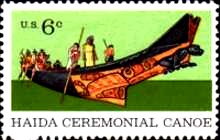
|
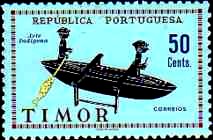
|
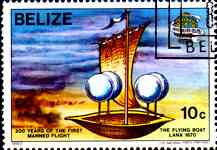
| |
The dugout in the world of arts and science. At left a native carving of a
canoe model. On the right, the design of a ‘Flying Boat’ executed by
Francesco Lana-Terzi, physics and math professor in Brescia, Italy, in the
year 1670. The boat was not pure fantasy but a result of detailed
mathematical calculations based on principles pronounced by Archimedes and
Euclid. Once the air was sucked out of its four spheres, the dugout was to
become lighter than the surrounding atmosphere and hence would be able to
fly. Alas, this airship was never built, as the good professor was afraid of
divine displeasure.
|
|